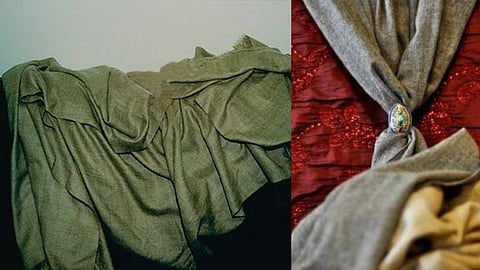
- HOMEGROWN WORLD
- #HGCREATORS
- #HGEXPLORE
- #HGVOICES
- #HGSHOP
- CAREERS
- ABOUT US
- CONTACT US

Once donned by Emperors of the Mughal Period, and later adopted by high fashion brands like Valentino, Yves Saint Laurent, and Hermes, shahtoosh shawls have a long and murky history. Shahtoosh, or ‘king of wools’, in Persian, is considered to be the finest and most expensive animal wool, made from the hair of the endangered ‘chiru’ or Tibetan antelope in China’s Changtang region. The animal’s wool is then carefully woven into exquisite shawls in the Kashmir valley of India, using traditional weaving techniques that have been passed down through generations of artisans. Shahtoosh has been coveted for centuries for its softness, warmth, and fine threads.
But behind the luxury of shahtoosh fabric lies a dark and controversial history, rooted in illegal poaching, unethical production practices, and the decline of an endangered species.
The Tibetan antelope, found in subzero temperatures and high altitudes, develops a valuable ‘underfur’ that is incredibly soft, warm, and lightweight. However, the antelopes cannot be domesticated for their wool, leading to their poaching to acquire the undercoat of their fur. It takes four chirus worth of fur to produce a single shawl, which is incredibly thin and lightweight — so much so that a whole shawl can be passed through a ring. Shahtoosh shawls had a huge prominence in elite circles that were willing to spend fortunes on them, and they eventually became status symbols for celebrities, socialites and the 1% of society.
In 1979, the trade and production of shahtoosh shawls was made illegal in most countries by the Convention on International Trade in Endangered Species of Wild Fauna and Flora (CITES) to protect the rapidly diminishing Tibetan antelope population, whose numbers had dwindled to 10% of their original number. In the early 2000s, the Indian government also banned the production and trade of shahtoosh shawls to protect the endangered Tibetan antelope species. Trading or possession of shahtoosh shawls have severe legal repercussions, including hefty fines or imprisonment.
Despite the ban, the demand for these shawls remained high, and they continue to be sold on the black market for astronomical prices, with a single scarf costing up to $20,000 USD. Currently, the market for shahtoosh is valued at $20 million USD. Trade and production may have formally halted since years, but the illegal trade continues to thrive in remote parts of Kashmir, where artisans and weavers operate small, clandestine workshops. For generations, artisans in the Kashmir valley have been weaving shahtoosh shawls, a highly skilled craft that has been passed down through families. These artisans refute the claims that the production of shahtoosh shawls involves the poaching of the Tibetan antelope. They argue that the wool is collected through shearing or from collecting the fur that the chirus left behind on bushes and shrubs when they shed their winter coats before the onset of summer. While this may be debatable and has no way of being proven after the bans, certain Shahtoosh weavers pivoted to weaving Pashmina shawls, which are made from the Himalayan goat’s sheared fur, hence posing no threat to the animals.
The shahtoosh shawl trade serves as a reminder of the impact of unethical practices on endangered species. While the ban on shahtoosh shawls has made it illegal to trade these products, the continued demand for them in the black market reinforces the need for ethical and informed consumption that is sustainable for the environment in the long term.
If you enjoyed reading this, here's more from Homegrown:
What The Map Shawl Of Kashmir Reveals About The History Of Its Shawl Makers
The Legacy of Kashmir’s Oldest Handcrafted Shawl
Pashmina: Tracing The History And Struggles Of Srinagar’s Endangered Legacy Craft
